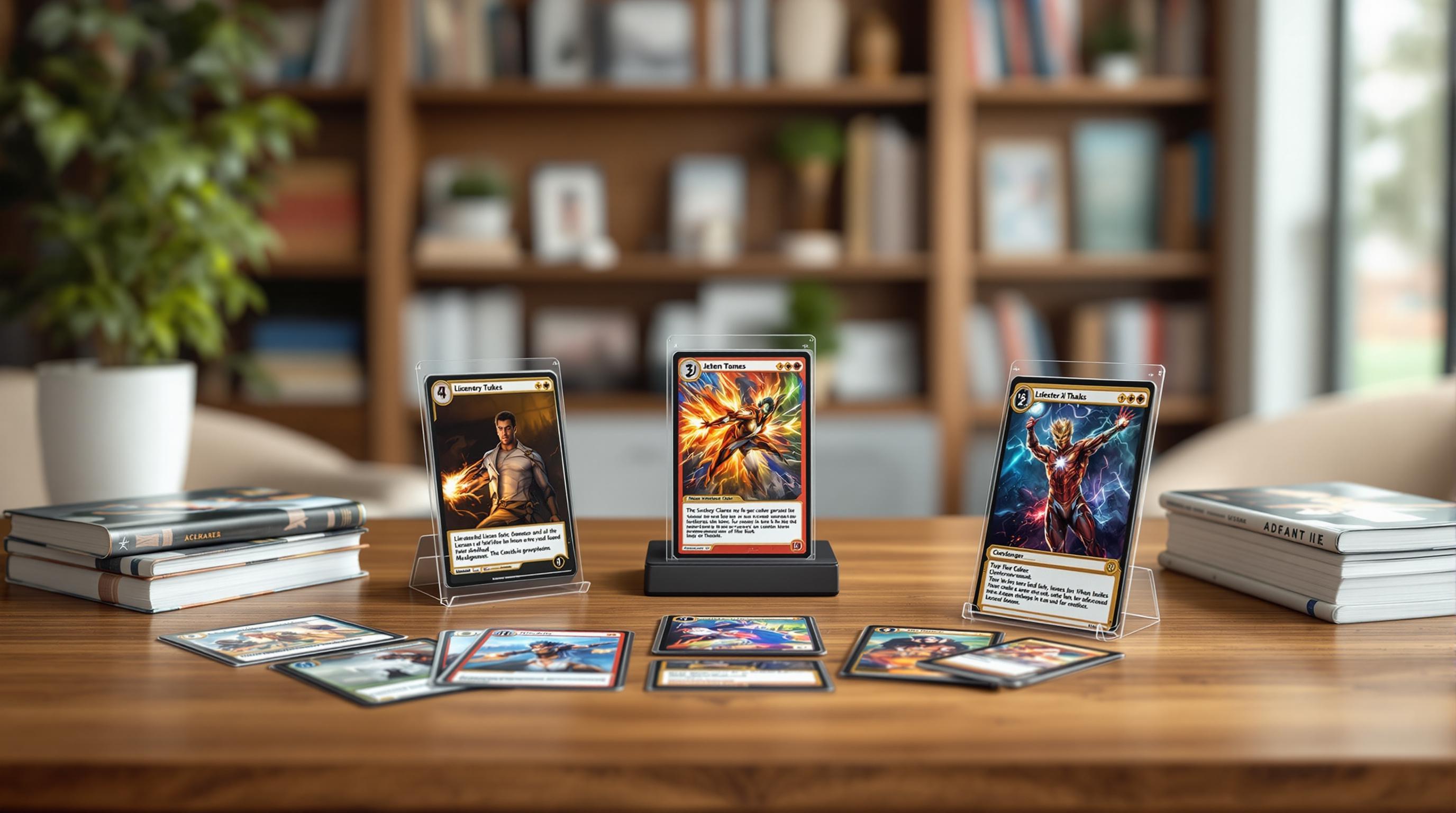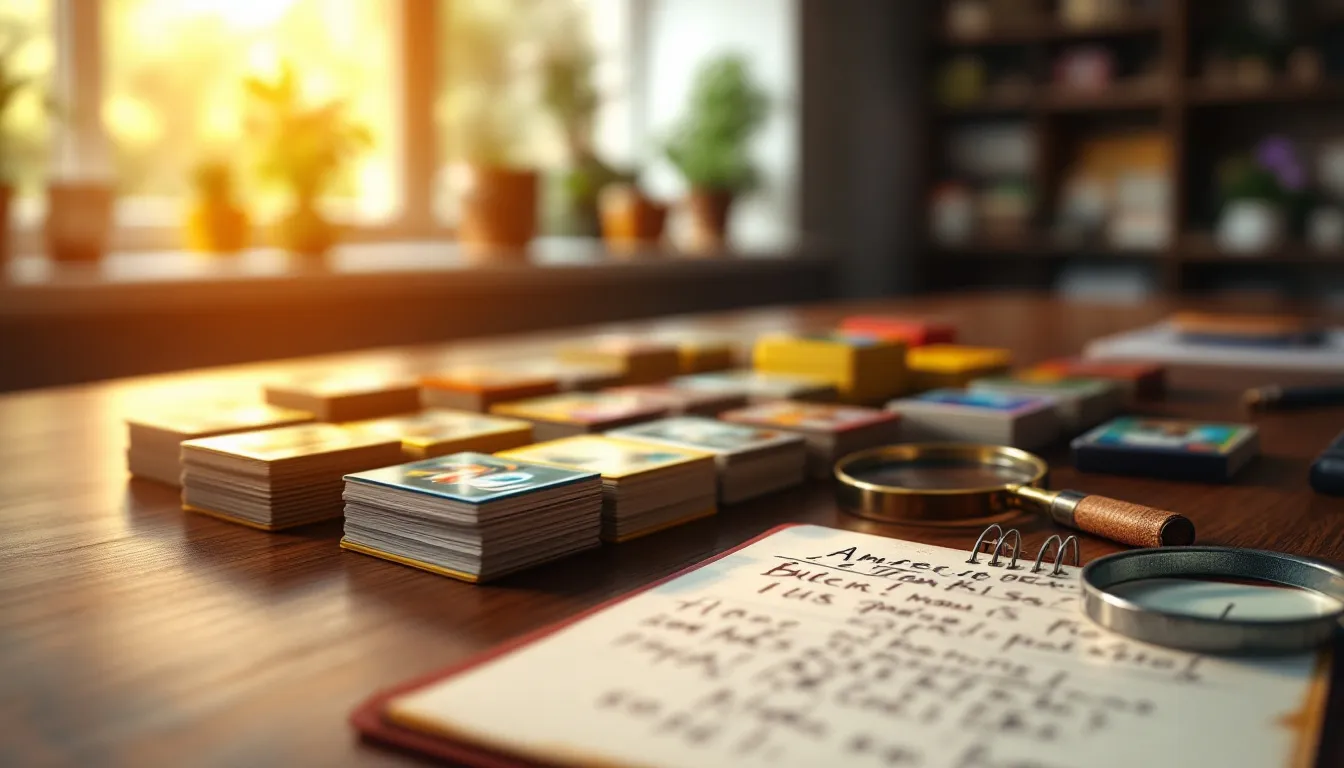: Hidden Gems for Collectors
Spot valuable card misprints with this quick guide:
- What are misprints? Factory errors during card production
- Types: Color issues, missing elements, misalignments
- Tools needed: Magnifiers, good lighting, card guides
- How to check: Compare with normal cards, feel texture, use magnifier
- Value factors: Rarity, collector demand, professional grading
Key takeaway: Not all misprints are valuable, but rare errors on popular cards can be worth thousands.
Related video from YouTube
Quick Comparison: Common Misprints vs. Damage
| Aspect | Misprints | Damage |
|---|---|---|
| Origin | Factory errors | Post-production wear |
| Value impact | Often increases | Usually decreases |
| Consistency | Same error on multiple cards | Unique to each card |
| Examples | Miscuts, wrong colors | Creases, water damage |
What Are Card Misprints
Card misprints are errors that happen during manufacturing. They're not the same as wear and tear - these quirks are born in the factory. And guess what? Collectors often love them.
Types of Print Mistakes
Misprints come in all shapes and sizes:
- Ink gone wild: Too much, too little, or just plain wrong colors
- Miscuts: Cards sliced incorrectly, sometimes showing bits of other cards
- Missing stuff: Cards lacking certain printed features
- Misplaced elements: Things printed where they shouldn't be
Take the Pokémon Jungle set. Some cards are missing the Jungle icon. Oops! Now they're collector's gold.
Main Misprint Categories
Let's break it down:
- Color chaos: Wrong colors or weird color shifts
- Text troubles: Typos, wrong text, or vanishing words
- Graphic glitches: Wrong images, missing graphics, or misplaced elements
- Structural slip-ups: Physical issues like crimping or wrong card stock
Remember the Grayscale Pokémon Card? It's one of the first error cards in Pokémon Booster packs. Even big mistakes can slip through!
Misprints vs. Damage
Don't mix up misprints and damaged cards. Here's the lowdown:
| Misprints | Damage |
|---|---|
| Factory flubs | Wear and tear |
| Often boost value | Usually tank value |
| Same error on multiple cards | Unique to each card |
| Think miscuts, wrong colors | Think creases, water damage |
"To the untrained eye, it can be difficult to tell the difference between a Missing Print Layer error and sun fading." - CGC Trading Cards
This quote nails it. Missing print layer? Factory goof. Sun fading? That's damage over time.
Spotting a misprint? Ask yourself:
- Does it match known factory mistakes?
- Any signs of tampering?
- Can you find other cards with the same error?
Real misprints happen during production. If it looks altered after the fact, it's probably damage or tampering, not a true misprint.
Getting to know misprints makes collecting more fun. You might even find hidden gems in your own stash. The more you learn, the better you'll get at spotting these unique cards and appreciating the quirks of card production.
Tools You Need
To spot card misprints like a pro, you need the right tools. Here's what you should have in your toolkit:
Magnifiers
A good magnifier is crucial for misprint hunting. Here are some options:
- Pocket microscope: The Carson MicroBrite Plus 60x-120x Power LED Lighted Pocket Microscope ($15) offers variable zoom and a built-in LED light.
- Cell phone clip-on microscope: For $6.99, turn your smartphone into a magnification tool.
- USB microscope: Ranging from $22.99 to $66.99, these offer high-res images and easy screenshots.
Travis Nance, a misprint expert, says: "There's no reason to not own one of the above options. Loupes provide a limited amount of magnification and most scanners are inadequate for true misprint inspection."
Lighting
Good lighting is key:
- LED desk lamp: Use a flexible, adjustable lamp to control shadows and glare.
- Natural light: When possible, examine cards in daylight for accurate color.
Check cards under different light sources to catch all potential errors.
Card Guides
You need reliable references to compare suspected misprints:
- Official card databases: Use online databases from card game companies.
- Collector's guides: Get up-to-date printed guides for your specific cards.
- Online forums: Join collector communities to learn about rare misprints.
Expert Help
When you're unsure, get professional verification:
- Grading services: Companies like PSA, BGS, and CGC can authenticate misprints.
- Specialty shops: Some card shops specialize in misprints. Check Card Shops List for stores near you.
- Online communities: Platforms like Reddit's r/mtgmisprints can provide second opinions.
ShopGoodwill Blog advises: "Seek advice from trusted sources - Reputable Pokémon TCG communities, professional grading services, or experienced collectors can provide you with valuable insights."
Spotting Print Problems
Got your tools ready? Let's jump into finding print problems on cards. These errors can turn a regular card into a collector's goldmine!
Color Problems
Color issues often stick out like a sore thumb. Here's what to watch for:
Wrong colors: Stack the card up against a known good one. Take the Unlimited Blaine's Charizard (#2/132). It's got a Fighting energy symbol where there should be a Fire energy in its Roaring Flames attack. Oops!
Ink bleeding: Colors spilling where they shouldn't? Grab your magnifier and check those edges and borders.
Color shifts: Sometimes cards get an unwanted tint. One collector stumbled upon Homelands cards with blue-tinted white areas.
"I checked with a jeweler's loupe. This isn't a case of someone doodling blue on the cards years ago." - Anonymous collector
Missing Parts
Missing elements can make collectors drool. Look out for:
Missing text: Card name, description, or stats gone AWOL?
Missing images: Blank spaces where art should be?
Missing foil stamps: Some cards might be missing their shiny bits. The 1st Edition Dragonite "No holo" error (#5/82) looks like its non-holo twin but with a holo card set number.
Wrong Placement
Misalignments and cutting mishaps can create one-of-a-kind misprints:
Off-center prints: Uneven borders? The more off-kilter, the more valuable it might be.
Miscuts: When cards are cut wrong from the sheet. Big miscuts might even show bits of other cards!
Printer hickeys: Tiny spots caused by dirt on the printing plate. Time to whip out that magnifier!
sbb-itb-0db97a5
Checking if Misprints are Real
Want to know if that weird-looking Pokémon card is a legit misprint or just a fake? Let's break it down.
Factory Checks
Here's how to tell if a misprint came straight from the Pokémon factory:
1. Compare with other cards
Put your card next to others from the same set. Look for differences in text, color, or alignment that stand out.
2. Feel the card
Real cards have a specific thickness and texture. If your misprint feels the same as other legit cards, that's a good sign.
3. Get up close and personal
Grab a magnifying glass and check out the printing patterns. Factory misprints will have the same errors all over the card.
4. Check the numbers
Make sure the Collector's Rare Number (CRN) matches the card's set and rarity. Fakes often mess this up.
A PokéBeach.com user shared their experience with a Rare Candy secret rare card:
"I measured the card and found it was misaligned. The front had a 1.5mm difference, while the rear measurements varied."
This kind of detailed inspection can help you spot real factory misprints.
Common Factory Errors
Knowing what to look for makes spotting real misprints easier. Here are some typical factory mistakes:
- Cards with weird color tints
- Cards cut wrong, sometimes showing bits of other cards
- Missing text, images, or foil stamps
- Ink problems like too much, too little, or bleeding colors
For example, some Unlimited Blaine's Charizard cards have a Fighting energy symbol instead of a Fire energy symbol in the Roaring Flames attack. That's a clear factory goof-up.
Spotting Fake Misprints
Some people try to make fake misprints to cash in. Here's how to catch them:
- Check the text: Real Pokémon cards have clear, sharp text. Fakes often look a bit off.
- Look at the colors: Authentic cards have bright, crisp colors. Fakes might look faded or too dark.
- Flip it over: The blue color and Poké Ball details on the back should be spot-on. Fakes often get this wrong.
- Holo check: If it's a holographic card, take a close look. Real cards have high-quality holo effects that are tough to copy.
The ShopGoodwill.com Team gives this advice:
"Seek advice from trusted sources - Reputable Pokémon TCG communities, professional grading services, or experienced collectors can provide you with valuable insights."
What Makes Misprints Worth Money
Not all misprints are created equal. Some are worth big bucks, while others might not even get a second glance. So, what's the secret sauce that makes certain misprints valuable? Let's break it down.
How Rare Is It
Rarity is king in the misprint world. The harder it is to find, the more collectors will pay. Here's the deal:
Limited print runs are gold. Take the 1990 Topps Frank Thomas No Name On Front (NNOF) Error Card. Only 200-500 exist, and it's sold for over $7,000 in PSA 7 condition. That's some serious cash for a printing oops.
Unique errors can break the bank. A Pokémon card with a Magic: The Gathering back? That's a $216,000 mistake. Why? It's one of only three known to exist.
Popular characters boost value. The Shadowless Charizard misprint is worth $420,000 for a PSA 10 grade. With just 121 cards graded PSA 10, it's a collector's dream.
What Collectors Want
Collector interest can turn a simple mistake into a goldmine. Here's what gets collectors excited:
Notoriety sells. Remember the 1989 Fleer Billy Ripken card with the naughty word on the bat handle? That error caused a stir and sent collectors into a frenzy.
Visual appeal matters. Miscut cards showing parts of other cards or severely off-center prints often catch collectors' eyes.
Historical significance can jack up the price. The 1952 Topps Johnny Sain card with the wrong bio on the back? It's a piece of card-making history that collectors love.
Getting Cards Graded
Professional grading can make or break a misprint's value. Here's why:
Authentication is crucial. Grading services like PSA, BGS, and CGC can confirm if a misprint is the real deal.
Condition assessment still counts. Even for misprints, better condition means higher value.
Market confidence goes up with grading. Buyers are more willing to shell out cash for a card that's been professionally evaluated.
"The value of error-containing cards keeps going up", says Quinton O'Connor, a card collecting expert.
Remember, not every misprint is a jackpot. Common errors or less popular cards might not see much of a price bump. But for the right card with the right error? You could be sitting on a gold mine.
Looking to dive into the world of misprint cards? Check out Card Shops List. Many shops there deal in rare and misprint cards, offering expert advice and grading services to help you navigate this wild corner of collecting.
Card Shops List

Looking for misprints? Your local card shop might be the ace up your sleeve. These stores often have experts who can spot rare errors and help you figure out what they're worth. Let's see how Card Shops List can connect you with these knowledge goldmines.
Card Shops List is a big directory that helps collectors find specialized card shops. Why visit a local shop? Simple:
- The staff have probably seen tons of cards, so they're good at spotting weird misprints.
- You can actually hold the cards and get feedback right away.
- Many shops can help you get your misprint graded professionally.
Some shops are especially good for misprint hunters:
1. Dave & Adams in Buffalo, New York
They've got a huge selection and staff who really know their stuff. They've seen so many cards that they're great at spotting odd misprints.
2. The Bullpen in Los Angeles, California
These guys focus on top-notch baseball singles. They can help with grading too, which is super important for proving your misprint is real and figuring out its value.
3. Hoody's Collectibles in Beaverton, Oregon
Hoody's deals with high-value items a lot, including misprints. They even run auctions for unique cards.
When you use Card Shops List to find a local store, remember:
- Call them first. Ask if they know about misprints in your specific game or sport.
- If you can, bring pictures of known misprints to compare.
- Keep an open mind. Even if your card isn't worth much, you might learn something useful for next time.
Card shops can be goldmines for misprint hunters. With Card Shops List, you're just a few clicks away from tapping into that expertise.
Summary
Spotting card misprints can turn you into a treasure hunter. Here's what you need to know:
Types of Misprints
Misprints come in all shapes and sizes:
- Color issues (wrong colors, bleeding ink, shifted colors)
- Missing elements (text, images, foil stamps)
- Misalignments (off-center prints, miscuts, printer hickeys)
Take the Unlimited Blaine's Charizard (#2/132). It's got a Fighting energy symbol instead of Fire for its Roaring Flames attack. That's a factory error collectors go nuts for.
Tools You'll Need
To spot these gems, you'll want:
- Magnifiers (pocket microscopes, phone clip-ons, USB scopes)
- Good lighting (LED desk lamps, natural light)
- Card guides (official databases, collector's guides)
- Expert help (grading services, specialty shops)
Travis Nance, a misprint guru, says:
"There's no reason to not own one of the above options. Loupes provide a limited amount of magnification and most scanners are inadequate for true misprint inspection."
Is It Real?
To make sure you're not getting duped:
- Compare it with other cards from the set
- Feel the card's texture and thickness
- Use a magnifier to check printing patterns
- Look up the Collector's Rare Number (CRN)
Here's a pro tip: Real Pokémon cards use 305-310 gsm black core card stock. They've got a distinct "snap" when you bend them.
What Makes It Valuable?
Not all misprints are created equal. Their worth depends on:
- How rare they are (limited prints, one-of-a-kind errors)
- How much collectors want them (fame, looks, historical importance)
- Professional grading (authentication, condition check)
For example, the 1990 Topps Frank Thomas No Name On Front (NNOF) Error Card is SUPER rare. Only 200-500 exist. A PSA 7 grade? That'll set you back over $7,000.
Wrapping Up
Quinton O'Connor, a card collecting expert, puts it this way:
"The value of error-containing cards keeps going up."
But remember, there's a big difference between a real misprint and a damaged or fake card. Not sure? Ask the pros. Check out specialty shops on Card Shops List for expert eyes.
FAQs
How do I know if a card is a misprint?
Misprints are cards with manufacturing errors. Here's what to look for:
- Text or ink that's missing or extra
- Weird holo patterns
- Square corners (instead of rounded)
- Images that are off-center or misaligned
- Wrong colors or color bleeding
Don't confuse wear and tear with misprints. Use a magnifier to get a close look at suspected errors.
Is a miscut card an error card?
Yep, miscut cards are error cards. They happen when sheets aren't lined up right during cutting. Miscuts are common, but they can still be valuable. Two things determine a miscut's worth:
1. The card itself (how rare and popular it is)
2. How bad the miscut is
As BBC Emporium puts it: "Miscuts are one of the most common types of errors, but that doesn't mean they aren't valuable."
For a card to be a true miscut, you should see part of another card from the printing sheet on it.
Are misprinted cards worth anything?
Misprinted cards can be valuable, but it's not a sure thing. Their worth depends on:
- How rare the error is
- How popular the card is
- How severe the misprint is
Think about it this way: a slightly off-center common card might not be worth much more than normal. But a severely miscut rare Pokémon or Magic: The Gathering card? That could be worth a LOT to collectors.


